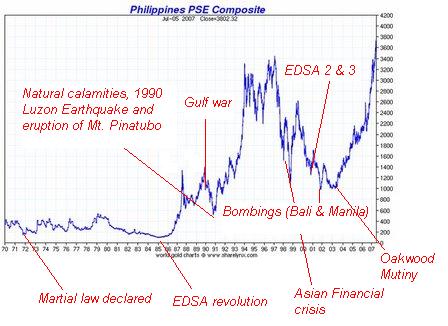I’ve been bugged by several readers on the next installment of the post “Follow Warren Buffett’s signal on when to buy – Part 1” So finally here it is!
This was originally planned to be only a two part series but it seems that there is so much to discuss on the subject on when to buy stocks.
Last time I gave an introduction on knowing when to buy stocks like Warren Buffett. Knowing when to buy is perhaps as important as “what to buy” since the “price you pay determines you rate of return.” The lower the price, the higher the rate of return, hence a good investor needs to time the market for fair prices of wonderful businesses.
I emphasized before that Warren Buffett is not only very good in sizing up a company’s fundamentals; he is also very good in knowing when to buy stocks. So how does Buffett know when to buy stocks? What could we learn from him?
Noted Buffetologists, Mary Buffett and David Clark author of “The New Buffetology” outlines five situations on how Warren Buffett determines when to buy stocks. They have given examples in the American setting; however I will do my best to fit them in the Philippine setting. I’m going to discuss two of them in this post.
1.) Stock market panic – This is the number one indicator on when to buy stocks. Stock market correction or panic is usually very easy to spot. Newspapers usually herald this kind of news. While stock market speculators are saddened by bad news, fundamental investors on the other hand adopt a “there is no better news than bad news” attitude.
The main cause of Stock Market panic is of course “bad news.” The cause of bad news could be anything ranging from unstable political conditions, unstable economic conditions both domestic and abroad etc. The chart below illustrates how the Philippine stock market reacted to bad news from 1970 up to 2007.

You can see that during these times, the market hit the bottom indicating a perfect answer to the question as to when to buy stocks.
2.) Industry Recessions – Industry recessions are when entire industries suffer a financial setback. The stock market is categorized into industries. For example in the Philippines we have categorized them into the following, financials, industrial, holding firms, property, services, mining & oil etc.
An example of this can be seen in the financial and property sectors during the 1997 the Asian Financial crises. As we all know, the property sector is very dependent on the financial sector because sales and lease of houses, office and building spaces largely depend on the availability of credit from the financial sector. Trouble in the financial sector also spells trouble in the property sector. Because of this, prices of stocks in these sectors in 1997 are sold way below their book values. Examples of these are Megaworld (MEG), Filinvest land (FLI) and Robinson’s land (RLC) among others which were sold in the stock market for more than 50 % below their book values. It happened in 1997 and it is happening now in the world financial crisis of 2008 and 2009 !
You should consider situations like as the perfect time on when to buy stocks. Warren Buffett buys stocks in these situations and so should you.
Click here for the continuation of “Follow Warren Buffett’s signal on when to buy stocks – Part 3”
In the meantime, learn more on how the master investor does it. Check out cheap Warren Buffett books at my Guerilla Blogger estore.
 Hi ! my name is Zigfred Diaz. Thanks for visiting my personal blog ! Never miss a post from this blog. Subscribe to my full feeds for free. Click here to subscribe to zdiaz.com by Email
Hi ! my name is Zigfred Diaz. Thanks for visiting my personal blog ! Never miss a post from this blog. Subscribe to my full feeds for free. Click here to subscribe to zdiaz.com by Email
You may also want to visit my other blogs. Click here to learn more about great travel ideas.

nindot ta ni cya sir pero lapaman tawn tay ikapalit ug stocks wabnnananyayayyahahahahah
anyway have u hear of the news of online content licensing? what are your thoughts? see the post on my blog..
Iggy: Hinay2x lang gud. Tigom sa sa pagka karon bata pa bitaw ka hehehehehe
Yep I’ve heard the news about online content licensing. I’ve also read your post on it. I’ll write about it soon
Hi,
In the given graph above, the PSE plummeted in value in the years 1999 and 2002. Say if I had 100,000 during the year 1997, come 1999, its value would have gone down to just 30,000 (which could be quite emotionally disorienting). I understand that even if I would have lost 60K during that time, if I have added an investment of 50K in 1999 and another 50K in 2002 instead of pulling out my money, I would have re-gained the loss and have earned up to 481,000 (approx) in the 2007 bull market (not counting the other purchases in between).
Is my understanding correct? That even though a bear market strikes once in a while, it’s never really a loss (if you invested in really good companies) but instead an opportunity to buy more stocks so that you will have maximized your gains when it’s finally time for you to redeem your shares (say after 20 years).
indiebot: Hi ! Thanks for all your questions. I will be writing a post about your questions soon. I will inform you via email once I have it posted. Thanks for dropping by.